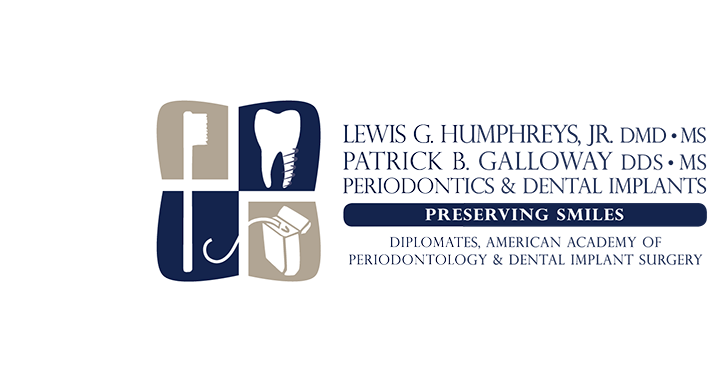Frequently Asked Questions

What is a periodontist? Do I need to see one?
A periodontist specializes in the diagnosis, treatment and prevention of periodontal disease, as well as dental implant placement. All periodontists are general dentists, but they receive additional training of up to three years after dental school to obtain the necessary education to perform procedures in periodontics. Your general dentist may refer you to Dr. Humphreys or Dr. Galloway if you exhibit the symptoms of gum disease. However, you may schedule an appointment on your own if you have concerns about your oral health.
What is periodontal disease, and am I at risk of developing it?
The term “periodontal” simply means “around the tooth.” Periodontal disease affects the gums and bones supporting the teeth. Also known as gum disease, periodontal disease is mainly attributed to the bacteria in dental plaque, which causes the gums to become inflamed and infected. Other factors, such as smoking or tobacco use, poor nutrition, stress or pregnancy, may put you at risk of developing gum disease.
Is periodontal disease contagious?
Although it is not an airborne disease, research has indicated that the bacteria that cause gum disease can be passed through saliva. Therefore, families and couples who may be in close contact with a person with gum disease are also at risk. We recommend being screened for periodontal disease regularly if you are potentially at risk.
My gums bleed when I brush my teeth. Is this normal?
Healthy gums should not bleed when you brush your teeth. This is one of the early signs of gum disease. You should schedule an appointment with for a complete periodontal screening.
Are there any ways to prevent periodontal disease?
A good oral hygiene regimen is imperative in preventing periodontal disease. Proper brushing and flossing, in conjunction with regular dental visits for professional cleanings twice a year, will help keep your smile healthy for life.
Are dental implants the best restoration option?
Dr. Humphreys or Dr. Galloway and your general dentist can determine if dental implants are your best restoration option for your individual case. Dental implants have a natural look and feel and can help prevent shifting of surrounding teeth. Implants are often preferred to bridges and dentures because they are more secure and can help prevent bone loss. Also, adjacent teeth are not affected by the placement of implants. We offer complimentary dental implant consultations.
If I have periodontal disease, do I need surgery? What are my options?
Whether you need surgery or not will depend on how advanced your periodontal disease is. There are non-surgical treatments, such as scaling and root planing available, for those with mild gum disease. If you are in the advanced stages of gum disease, you may benefit from having surgery. With the latest technology and advanced techniques available today, many surgical procedures can be performed in an office setting with little discomfort.
What is maintenance therapy?
Maintenance therapy is used to help prevent further infection from occurring in patients who have already received periodontal treatment. Dr. Humphreys or Dr. Galloway and your general dentist will tailor a program to fit your needs, which will include periodontal checkups, plaque and tartar removal and sometimes polishing your teeth or checking your bite. The frequency of visits varies from case to case, from every few weeks to four times per year.
I have a “gummy” smile. What can be done to correct this?
A procedure called esthetic crown lengthening can correct “gummy” smiles. “Gummy” smiles make teeth appear too short. With esthetic crown lengthening, the gums and supporting tissues are reshaped to expose more of the tooth.
My gums are receding and my teeth appear “long.” Can this be fixed?
If left untreated, gum recession can lead to tooth loss. Soft tissue grafts can fix this condition and also prevent further recession or bone loss. In the procedure, gum tissue can be taken from your palate, another donor source, or a synthetic dental product can be used. This tissue or dental product is then placed over the exposed roots, which helps to even out the gum line and reduce sensitivity to hot and cold temperatures.





